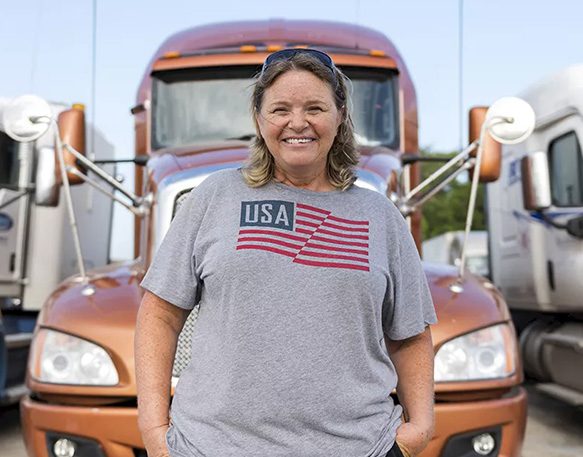Truck driver salaries vary depending on factors like job type, experience, and certifications. Whether you’re new to the industry or an experienced driver, understanding what influences your pay is essential. This article explores the different types of truck driving jobs, salary ranges for new and veteran drivers, and the impact of factors like specialty hauling and location. Learn how to maximize your earning potential and discover how tools like DAT’s load board can help you find the most profitable loads, ensuring you secure the highest truck driver salary possible.
Truck driver salary overview
According to Glassdoor, the average truck driver salary in the U.S. falls between $62,000 and $100,000, but of course, this can vary per trucker. Trucker salaries are often split between three main components:
- Base pay can be measured by truck driver salary per hour or per mile for hauling each load.
- Truck driver pay may also include any specialized pay for events like detention or layovers, which creates drivers idle without any loads.
- Bonuses can often amount to the largest portion of annual take home income for drivers. Common bonuses include sign-on, safety, monthly mileage, fuel efficiency, referral, and DOT inspection bonuses.
Depending on the type of driving or the distance covered on a typical trip, truck driver salaries can also vary. For example, Glassdoor cites that the average yearly pay for an over-the-road (OTR) driver ranges from $76,000 to $129,000, while owner-operators earn an average yearly salary of $228,575, according to ZipRecruiter. Of course, exact numbers will depend on your experience level, state of employment, freight types, company size, and more.
Truck driver salary: New vs. experienced drivers
As you might expect, holding all other factors equal, new truck drivers earn less money relative to their more experienced counterparts. A brand new truck driver with less than one year of experience will earn, on average, $18 per hour. This lower wage typically isn’t actually a wage for driving in itself, but instead training pay. That’s because most drivers will need to progress through a truck driving school for training and licensure before they can formally get on the road. During this training period, most schools pay a flat, low weekly rate of $18 per hour to each driver trainee, which will be the entirety of the driver’s salary for that period.
After completing your training and becoming fully licensed, your actual pay will become dependent on the type of job you take on—and whether or not you decide to become an independent owner-operator.
The more experienced you are as a truck driver, the more you naturally stand to make on average. That is especially true for those that earn certifications along the way. Certifications are a great way to distinguish yourself and can provide an accelerated pathway for you to start earning significant money in a few short years. Another good tip for increasing annual pay when first starting out is to pursue mileage-based jobs instead of hourly jobs.
Comparing small vs. large company truck driver salaries
On the surface, there is no real difference between the salaries of truck drivers working at small vs. large companies. But that doesn’t mean there aren’t other factors to consider when deciding which type of company will be best for you.
On the one hand, smaller companies naturally generate fewer discretionary funds that can be passed on to drivers. It’s also not uncommon for smaller companies to want drivers to work as independent contractors—a significant distinction that transfers the entire tax burden to the driver instead of the company. On the other hand, smaller companies in the midst of an active growth cycle usually invest more resources towards developing their own drivers. This provides an opportunity to gain greater exposure to senior management, owners, and other stakeholders in the trucking industry, which can lead to significant personal growth.
Larger trucking companies, meanwhile, typically have more discretionary income. Sometimes those additional funds can make their way to drivers, but it’s entirely dependent on each company’s philosophy. Some large companies might impose standard driver pay rates and rates corresponding to certifications and experience in the business. Others might offer free or deferred-payment training initiatives, relocation opportunities, or clear pathways to management—but once again, this varies from company to company. In other words, large companies have also been found to offer less training, pay lower flat rates, and cycle through high employee turnover more than small companies in some cases.
Every trucking company, small or large, is different in how they operate. And every trucker is different in terms of what they value most. Make sure you do your due diligence and prioritize what matters most to you before you rule certain companies in or out.
How much do OTR truck drivers make?
OTR (over-the-road) trucking is the most conventional form of truck driving. OTR drivers usually operate alone or in a two-person team to trek long distances on the road. These long hauls can often keep OTR drivers on the road for up to four weeks at a time. In order to become an OTR trucker you will need to earn either a Class A, B, or C CDL license depending on the specific equipment you end up operating. OTR trucker salaries are usually based on some combination of mileage (cost per mile) and bonuses. OTR drivers that pickup a HAZMAT endorsement along the way stand to benefit from a further uptick in pay.
As mentioned, the average OTR truck driver salary amounts to anywhere between $76,000 to $129,000, but the average salary for OTR drivers in their first year is around $57,000. Although OTR drivers usually primarily operate in the continental US, they may cross into Canada or Mexico.
While OTR truck drivers can make a sustainable living, it’s still critical to always consider the costs that cut into your paycheck. For one, OTR drivers must be aware of the federally mandated hours of service limitations that cap how much you can drive in a day or week. Other factors that can seriously affect OTR pay include delays—also known as detentions in the trucking space—weather conditions, and substandard road maintenance.
Average truck driver salary for owner-operators
One of the best ways to earn a significant bump in annual pay as a truck driver is to become an owner-operator. In fact, the average U.S. owner-operator makes nearly $229,000 in annual salary—a significant bump compared to the top average of $129,000 earned by OTR drivers. But beware—there are some catches to consider. That’s because owner-operators’ salaries are entirely dependent on their net revenue (how much yearly revenue they bring in minus their yearly expenses), meaning that number can fluctuate significantly from one owner-operator to another and even from one year to another.
Salaries also depend on whether you’re a leased-on or an independent owner-operator. Leased-on operators work under the authority of a carrier, meaning they often have more predictable income but less earning potential since they share revenue with the carrier. According to Glassdoor, these owner-operators can earn anywhere between $151,000-$282,000 a year.
Conversely, independent owner-operators are under their own authority, giving them the potential to earn more but also exposing them to greater risks and higher expenses. On average, independent owner-operators make around $333,264 a year, according to Indeed.
Since owner-operators are essentially running their own business, there are myriad expenses that can pile up, including:
- Cost of purchasing or leasing a truck
- Insurance costs
- Fuel costs
- Annual maintenance fees and taxes
- Customer acquisition costs
While there are certain tricks of the trade that savvy owner-operators can deploy to maximize revenue and minimize expenses, more net revenue still ultimately means a larger year-end tax bill.
The bottom line when considering whether to become an owner-operator is understanding that the entire set of responsibilities for jump-starting and sustaining your business falls on you. Depending on your sales skills, drive, and other circumstances, taking on these responsibilities can either prove to be a boon or a bust.
How do freight types and vehicle types affect truck driver salary?
There are a lot of different types of freight and vehicles to choose from. The type of vehicle you operate and the freight loads you take on play a big role in determining your take-home pay even before taking into account all the other considerations we’ve discussed. Holding all else equal, though, we’ve provided a brief overview on how the different freight loads affect driver pay:
- LTL — LTL (less-than-truckload) freight is a load that isn’t large enough to fill an entire truck. While Volume LTL freight has minimum size requirements, there are no minimum size requirements for traditional LTL freight. Most carriers therefore combine these smaller loads from a number of shippers to ensure a full truckload. Since LTL rates vary, truck drivers use load boards like DAT One to identify the most valuable LTL loads.
- Flatbed — For unusually shaped or sized items, flatbed truck drivers tow flat, open trailers instead of enclosed trailers. Flatbed loads can provide added difficulties for the driver because the driver must ensure the load remains secured and unaffected by any adverse weather. Because of these tasks, which demand specific skill sets, flatbed drivers can expect higher pay compared to some other freight. Much like LTL loads, flatbed drivers turn to load boards to source the best flatbed freight.
- Dry van — Dry van trailers refer to rolling boxes that contain no climate control. Shippers will typically turn to this more cost-effective shipping method for nonperishable freight. Keep in mind there is typically a high supply of dry van loads, which can put a ceiling on driver pay.
- Reefer — A reefer is a refrigerated trailer most commonly used for perishable goods that must be kept cold or frozen. Maintaining reefer trucks can become more complex compared to dry vans because of the onboard cooling system involved. But more complexity means higher rates for truckers, which means it can be worthwhile.
- Heavy haul — Heavy haul freight refers to overweight or oversized loads. Specialized equipment, licensing, and certifications are all required in order to haul these loads. As a result of the extra steps involved, heavy hauls can be some of the most lucrative loads for truckers.
- Hot shot — Hot shot truckers transport smaller loads (but still larger than LTL). Instead of staying on standby, the best way to find hot shot freight is through on-demand load boards like DAT One. Since hot shot loads are usually time-sensitive, shippers are often willing to pay a premium to ensure on-time delivery, resulting in high driver pay.
How much do CDL drivers make?
Technically, you need a CDL (commercial driver’s license) for any trucking job. Even though it’s not recommended, some companies may still choose to hire drivers who only possess regular driver’s licenses for certain jobs. If an accident occurs, however, the Department of Transportation (DOT) will undoubtedly check to see whether you should have possessed a CDL to legally carry out the job. The penalties can be damaging if they determine that you should have maintained a CDL for the specific job at hand.
There’s also a significant disparity in pay between CDL and non-CDL drivers even if they were to never get into an accident. Non-CDL jobs tend to not pay well compared to CDL jobs with the data showing that CDL truck driver salaries are substantially higher, even during the early portion of your career. In this context, it absolutely makes sense to pursue a CDL license as soon as you decide on pursuing a trucking career.
All it takes to obtain a CDL license is to go through truck driving school. Oftentimes the fees for your schooling aren’t required upfront. And once you earn your license, you now become eligible for better-paying, perfectly legal CDL trucking jobs.
Highest truck driver salaries by state
Truck driver salaries are influenced by local, regional, and state-driven supply and demand forces. A dedicated driver that exclusively works for one company can not only enjoy more time at home and focus on a single route, but also earn more than the average truck driver, with pay in the range of $60,000 to $80,000 per year. Regional drivers who work in a specific part of the country, on the other hand, usually only get to return home every week or two, and can expect to make a lower salary. Pay for regional drivers usually approaches anywhere from $37,840 to $56,249 per year.
While we’ve noted the different factors that also go into driver pay, such as company type, pay structure (hourly vs. mileage), variable bonuses, and equipment type, after accounting for these aforementioned inputs, some states still pay more than others. If you’re open to considering relocation options, understanding the most lucrative states for truckers becomes important.
According to the most recent Bureau of Labor Statistics analysis in 2023, the states where truck drivers earn the most are, in order:
- Alaska
- New Jersey
- D.C.
- Washington
- New York
How to achieve the best truck driver salary
Breaking into the trucking industry can be both rewarding and challenging, with many factors influencing your potential income. From the type of driving jobs you choose to the certifications you earn, the decisions you make early in your career can set the foundation for achieving the best truck driver salary possible. It’s crucial to stay informed about market conditions and continuously seek out ways to maximize your earnings, whether through niche hauling, bonuses, or becoming an owner-operator.
At DAT, we provide tools and resources to help you navigate these choices and secure the highest truck driver salary possible. Our extensive freight network gives you access to thousands of loads every day, helping you find the most profitable opportunities. With the right approach and support, you can take control of your trucking career and thrive in this competitive industry.
Whether you’re a new driver or an experienced operator, keeping your goals in focus and utilizing the right resources is key to long-term success.
Find quality loads from trusted partners with DAT
While calling every shipper or broker to find loads can be time-consuming and tedious, securing the best loads with DAT is easy! You can quickly filter through thousands of loads to find the most profitable ones that help you achieve the highest truck driver salary possible.
Get started with the DAT load board today and take control of your earning potential!




